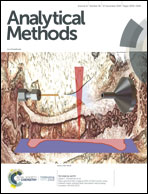Naphthalimide-linked bispyridinium clefts in selective aqueous sensing of triphosphate and triphosphate-based biomolecules†
Abstract
Naphthalimide-based charged sensors 1 and 2 have been designed and synthesized. Both the chemosensors selectively bind P3O105− (PPPi) in CH3CN–H2O (1 : 1, v/v, using 10 mM HEPES, pH = 6.8) exhibiting a marked quenching in emission and distinguish it from P2O74−, HP2O73− and other anions. Of the two structures, sensor 1 shows more sensitivity towards triphosphate. Moreover, both the compounds exhibit preferential interaction with triphosphate-based nucleotides over mono- and di-nucleotides by showing significant quenching of emission. For example, ATP is selectively sensed over ADP and AMP. Like ATP, other triphosphate-based nucleotides such as GTP, CTP and TTP show significant quenching of emission of both 1 and 2. Thus the designed sensors can also act as a marker of triphosphate-based nucleotides over their lower homologues. The ensembles of 1 and 2 with PPPi are also useful in probing enzymatic hydrolysis and in aqueous detection of Ca2+/Mg2+ ions.



 Please wait while we load your content...
Please wait while we load your content...